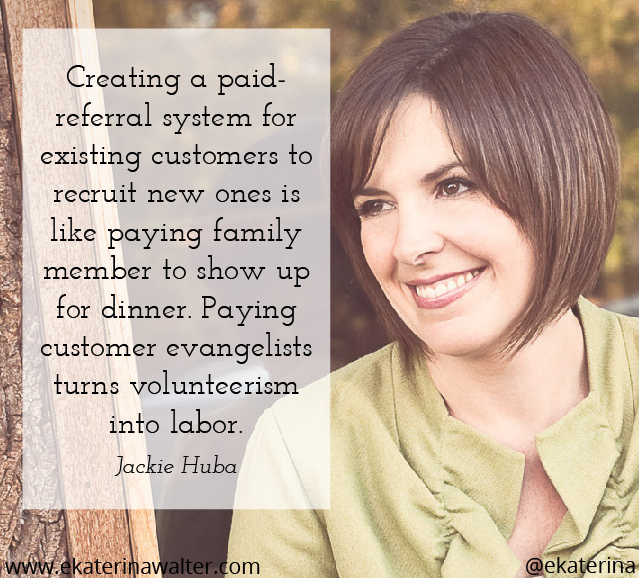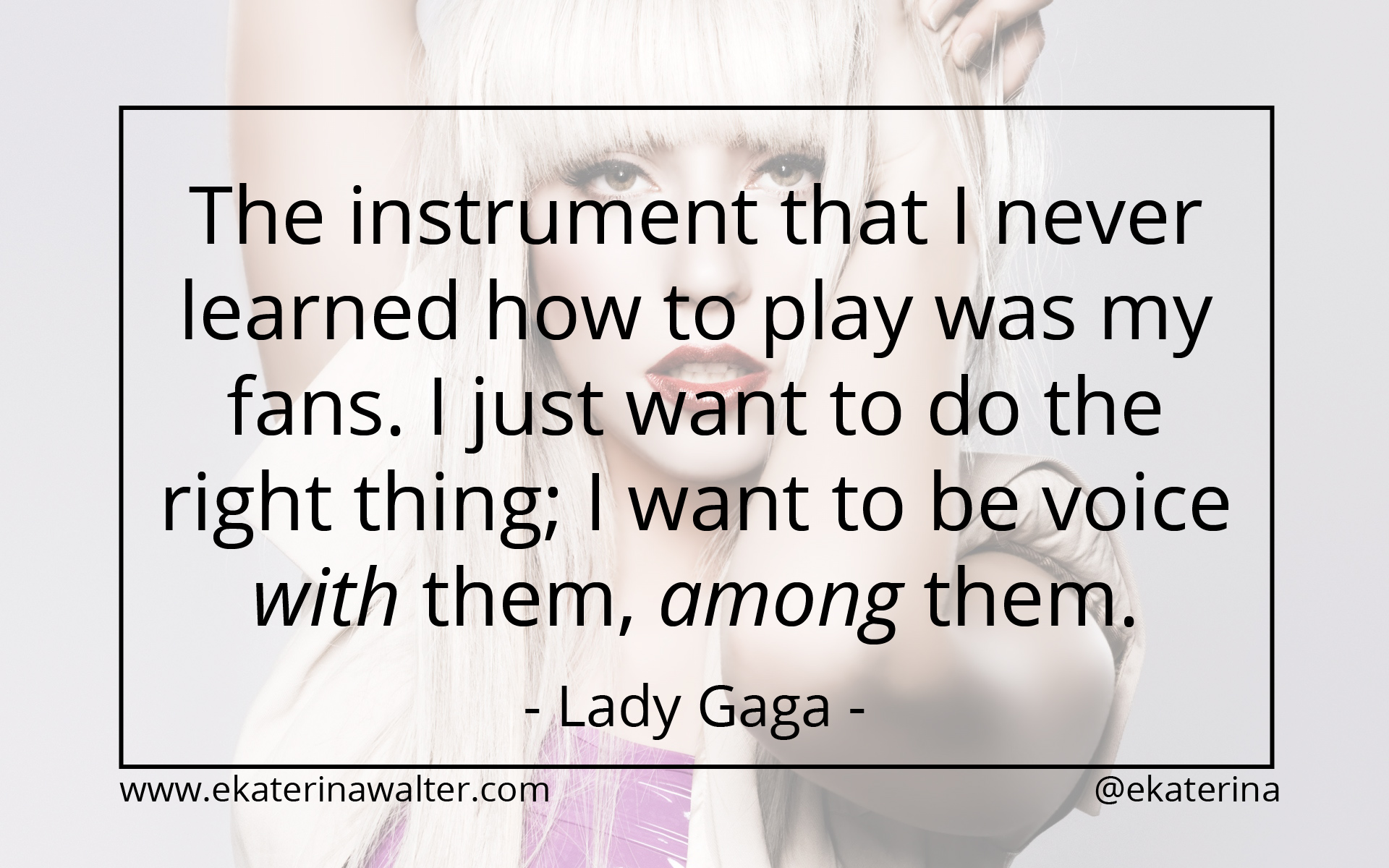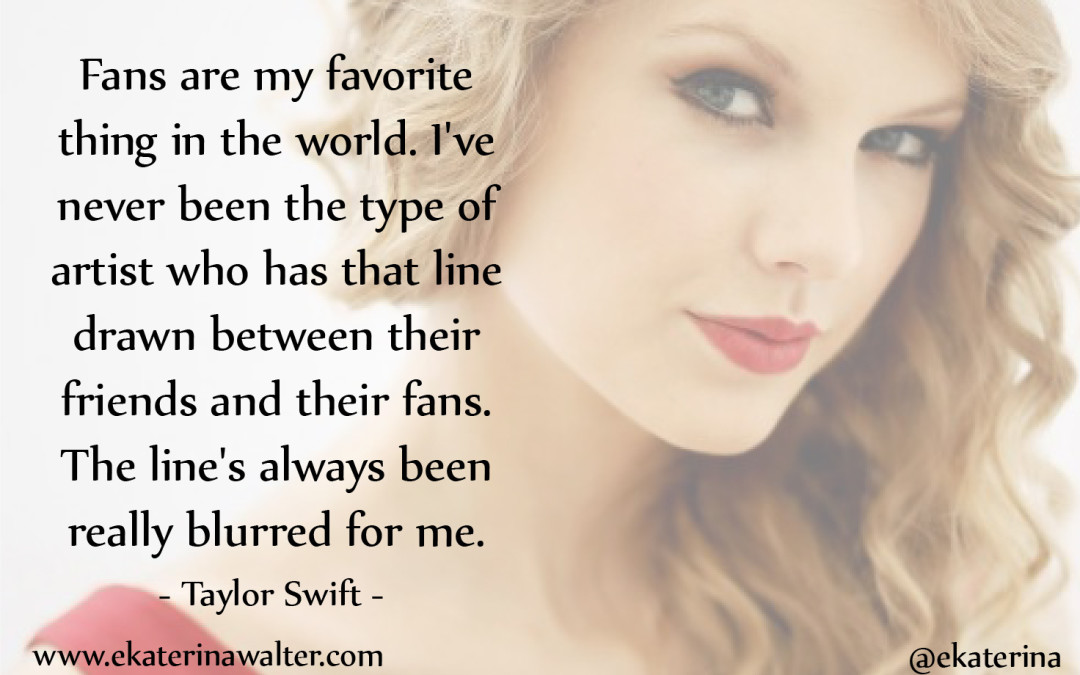Successful celebrities don’t have customers, they have fans. And that is their secret. They don’t aspire to conquer the “biggest share of the market”, they aspire to “ignite the movement and inspire their tribes”.
And that is the biggest difference between brands’ approach and artists’ approach to building communities and facilitating social dialogue. Brands are looking for new customers, whereas artists are looking to make their current fans happy. Why? Because they understand the ultimate truth: you make your current community happy, you appreciate and reward them for their advocacy, they will not only keep coming back, but they will bring new members with them to join your tribe… thus building sustainable brand love.
In his book “Think Like a Rock Star: How to Create Social Media and Marketing Strategies That Turn Customers Into Fans,” Mack Collier says: “This is something that rock stars have always understood. They view their fans as marketing partners. They see their fans are special people who are helping them promote and extend their brand, so they openly embrace their fans’ existing efforts and look for ways to have a deeper connection with them.”
How?
Highlight their stories. When Katy Perry launched her single “Firework,” she put the spotlight not on herself, but rather on her fans. She asked them to create videos telling the world who their Firework was (a person special to them, someone who inspired them). The first runner-up in her contest was a pair of best friends, one was hearing-impaired and another one was blind, who told a story about how important each of them had been to the other and how they both stood by each other in overcoming life’s challenges, including bullying. Collier points out the brilliance of this approach. “She gave her biggest fans a way to tell the whole world about the most important people their lives… In the process, she became a little bit more important to them as well.”
Give first. Amanda Palmer put on a secret show for her fans. To be eligible for a free ticket to the show all her fans had to do was to leave a comment on Get Glue about their favorite moment at her concert. The comments easily identified some of her most loyal fans through the most interesting experiences they shared at a number of her performances. Palmer does a lot of things like that for the fans who love her, consistently giving away her music for free. The marketer in you probably wonders how much money she lost by just giving away her music. But in reality she gained much more than just short-term revenue. She gained trust and respect of her fans. So when in 2012 she started a Kickstarter project to fund a tour to promote her new album and art book with the goal to raise $100,000 in 31 days, she raised $1,192,793. Amanda reached out to her fans via social media sites to start the dialogue about her new project and her fans rallied around her campaign. And, by the way, if you haven’t seen her TED speech, it is worth it!
Respect, reward, empower. After discovering a ton of fan-created YouTube videos using their music illegally, the band Blink-182, instead of pursuing illegal action against its fans (which, let’s be honest, is what most corporate brands would do), decided to reward them. The brand created a special music video for their about-to-be-released single “Up All Night” composed entirely of scenes from the fan-created videos. The band also thanked its fans and highlighted each fan at the end.
Connect on a personal level (online and offline). Taylor Swift is famous for her T-Parties. During her concerts her staff will scan the audience for the most excited fans, or those who may be wearing special outfits or signs they created especially for the event, and invite them to join Swift and her band for a T-Party after the show. It is an informal setting in which the artist can connect with her fans, give the fans an opportunity to connect with each other, and thank them for their support and their passion for her music.
Lady Gaga is also known for focusing on building long-term personal connections with her fans over the short-term revenue. Even though she could have played bigger venues early in her career (after all, the demand was there), she wanted to play small venues so that she could really connect with the audience.

In her book “Monster Loyalty: How Lady Gag Turns Followers into Fanatics” Jackie Huba states: “Many marketers would kill to have Lady Gaga as their ‘product’ to sell versus having to sell toilet paper or laundry detergent. Her catchy songs, crazy stage performances, and wacky outfits make her quite unique and buzz worthy. But I believe it is Lady Gaga’s ability to remain singularly focused on maintaining her fan base that has made her as successful as she is today. This is what sets her apart from the traditional way of doing business and where traditional businesses can learn the most from her success.”
Build and engage your tribe. Gaga is willing to invest now in the customer base that she wants years from now. “Most artists don’t have longevity today,” says Gaga. “I don’t wanna be one song. I wanna be the next 25 years of pop music.” She values her tribe members, who she affectionately calls “her Little Monsters”. She has built a custom social network so that she could connect with her fans on a personal level – Littlemonsters.com. She participates in the conversations often though posting/commenting/liking; she conducts contests, encouraging fans to work on projects together such as designing an outfit for her to wear or designing emoticons for her site. Fans themselves are coming up with projects and encourage other fans to participate and rally around the causes the community cares about. Gaga caters to a very specific audience and this is probably the most engaged, the most passionate community I have ever seen. “I’m not trying to gain new fans,” says Gaga. “I love the fans I already have, and [all I do] is for them.”
Make it about them. “What I do, in essence, create an atmosphere for my fans where they don’t leave loving me, they leave loving themselves,” Gaga told MTV. In her book, Huba gives numerous examples of how Gaga helps instill confidence in young people, giving them hope to dream and strength to fight for themselves. One such example is a story of the seventeen-year-old Jacque St. Pierre, a student council president of Etobicoke School of the Arts in Toronto, Canada. Jacque was promoting equality and anti-bullying, being bullied himself for years. He emailed dozens of celebrities, asking for help. The only one who replied was Lady Gaga. She sent him a video telling him how proud she was of his work to combat bullying, particularly bullying directed at gay and lesbian students. “There should be more Little Monsters like you,” she said. “It is important that we push the boundaries of love and acceptance.” When Jacque showed the video at the school assembly, it sparked a lot of positive conversations among the students who spoke up in support of diversity.

You are probably thinking that doing something like what Lady Gaga did for Jacque doesn’t scale. And you are right. It doesn’t always scale. But making a difference in the lives of others (especially those who love and support your art, no matter what it is) goes a long way towards nurturing brand love and advocacy.
On that note, the last thought I’ll leave you with is…
Be genuine and authentic, always. Give a damn! In 2010 Taylor Swift did an autograph signing in Nashville as part of the CMA Music Festival. Not only did she not charge her fans for the autographs, she spent 15 hours that day signing them to ensure that no fan who waited in line was left behind without an autograph. WOW! When was the last time one of the corporate executives spent this amount of time and energy for his/her loyal customers, no matter what that customer spent with the company, in a personal setting?
The future of marketing belongs to brands that not only understand their advocates, but go extra mile to build personal connections with their biggest fans and nurture authentic, long-term relationship with them.
Originally posted in Forbes

